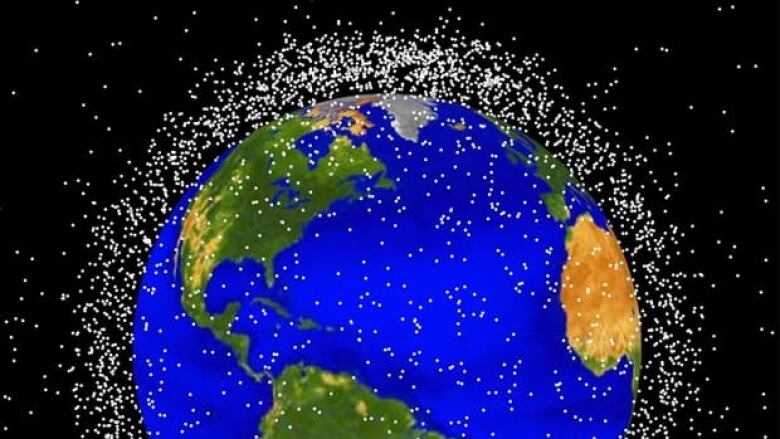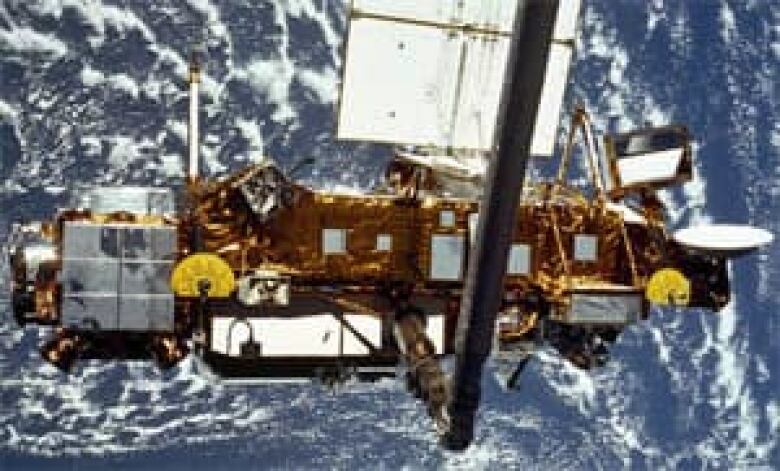Space junk, by the numbers

The latest major piece of space junk is Russia's unmanned Phobos-Ground probe, which malfunctioned after launch in late 2011 and started tofall back to Earth. At 13.2 metric tons, the Phobos-Ground is one of the heaviest pieces of space debris ever, with highly toxic fuel accounting for the bulk of its weight.
The probe's plighthas put a spotlight on the growing issue of Earth's orbital clutter. As the old saying goes, what goes up must come down, whether it's a fleck of paint from the side of a spacecraft, a bit of an expendedbooster rocket or a complete satellite.
On average, NASA estimates that a piece of debris falls back to Earth each day.
Most ofthose pieces are tiny, but some are very large. A decommissioned satellite the size of a bus re-entered the Earths atmosphere over the Pacific Ocean on Sept. 24, 2010, forexample. While most of the Upper Atmosphere Research Satellite (UARS) burned up upon re-entry, NASAwas concernedthat 26 potentially hazardous sections including four titanium fuel tanks and a heavy aluminium structure could strike Earth at speeds of between 90 and 385 kilometres an hour.
Space junk isthe common term for human-made debris that orbits the Earth. It can be applied to anything from the remains of old rockets, to the rather expensive tool bagthat drifted free from an astronaut outside the International Space Station (ISS) in November 2008.
Most orbital debris is located within 2,000 kilometresof the Earth's surface.While the objectsrange from very small to very large, the problem is that they can alsotravel at very high speeds up to28,800 km/h. Operating satellites and spacecraftorbit at high speed as well, and the closing speed in a collisionmeans thateven the smallest objects can pose a threat to satellites and manned craft.
According to Thinkquest.org, for example, a tiny bit of space debrismeasuring a few millimetres in diameter traveling at a closing speed of 35,000 kilometres per hourcould strike the space station with a force similar to that of abowling ball traveling at 100 kilometres per hour.
According to the NASA Orbital Debris Program Office, the International Space Station had to execute a "collision avoidance manoeuvre" on Jan. 13, 2012, to avoid a piece of orbital debris the sixth time its had to do so in two and a half years.
What goes up...

In order to dispose of them, engineers manipulate their propulsion systems to push them through the atmosphere, wheremuch of the structure isburned, and to steer them into unpopulated areas like deserts or oceans.
The Russian space station Mir, which was launched into orbit in 1986, was decommissionedin 2001. After a three-stage de-orbiting process that incinerated much of the structure upon re-entry, the remains of Mir crashed into the South Pacific Ocean on March 23, 2001.
The International Space Station is headed for a similar fate. Launched in 1998,it is scheduled to be de-orbited in 2020.
The 417,000-kilogram spacecraft loses approximately 30 metres ofaltitude every day, which is why several times a year it requires a boost back up above 350 kilometres. Thisis accomplished using an unmanned resupply craft and about 1,400 kilogramsof propellant.
What's up there
Here's a by-the-numbers look at the whirring, perilous state of space junk circling our planet.
1the first piece of man-made space junk was a piece of the rocket that launched Russia's Sputnik-1 satellite in 1957.
2% to 5% estimated annual increase in the amount of space junk orbiting Earth.
22,000 estimated number of pieces of space debris measuring 10 centimetres or more in diameter in 2011, according to the U.S. Strategic Command, up from 17,000 in 2007.
500,000-plus the current number of debris objects measuring between one and 10 centimetres, according to NASA's Orbital Debris Program Office.
2.3 million kilograms estimated mass of all the objects in low-Earth orbit in 2011.
6.3 million kilograms estimated mass of all the objects in Earth orbit at the beginning of 2012, up from about 1 million kilos in 1974 and 5 million kilos in 2004.
10% the percentage of the mass of human-made objects in low-Earth orbit in 2011 represented byoperating spacecraft and satellites.
90% the percentage of the mass of human-made objects in low-Earth orbit in 2011 represented byspace debris.
27.7% and 4.2% The percentage of the total number and total mass, respectively, of space junk that originated in China as of 2011, according to NASA.
28.4% and 23.4% The percentage of the total number and total mass, respectively, of space junk that originated in the United States as of 2011.
39% and 62.4% The percentage of the total number and total mass, respectively, of space junk that originated in the Russian Federation as of 2011.
27,000 km/h the average speed of most orbital debris in low Earth orbit (below 2,000 km).
36,000 km/h the average impact speed of orbital debris with another space object, according to NASA.
2.5 millimetres the size of the piece of debris that hit the Hubble Space Telescope solar arrayin 2002, requiring a space shuttle repair mission.
900 the number of pieces of debris created when China destroyed its Fengyun 1-C satellite in January 2007.
600 the number of pieces of debris estimated to have been released into space in the collision between the American Iridium 33 satellite and a Russian Kosmos 2251 military satellite in February 2009.
42,120 km/h the speed at which Iridium 33 and Kosmos 2251 collided. (A pea-sized piece of debris measuring one-centimetre andtravelling at 10 km/second has the same kinetic energy as a 250-kilogram dumpster whirring along at 100 km/hour, according to NASA.)
250 kilograms size of a propellant tank from a launch vehicle that landed near Georgetown, Tx, in 1997.
13.2 tonnes the mass of Russia's unmanned Phobos-Ground probe, which failed to reach orbit in late 2011 and returned to the surface in January 2012, becomingone of the largest pieces of space junk ever to plummet to Earth.
100 years the approximate amount of time that space debris that ismore than 1,000 kilometresabove the Earth's surface will continue to orbit the Earth before re-entering the atmosphere. Debris travelling in orbits below 600 kilometresfalls to Earth after several years. At altitudes below 400 kilometres, the debris is likely to fall to Earth before it has even been detected or identified.
36,000 kilometres the altitude at which most telecommunications and meteorological spacecraft rest.
30 km/h the estimated impact velocity of a light piece of debris falling to Earth. The velocity for larger objects is 300 km/hr, according to the Center for Orbital and Re-entry Debris Studies.
$100,000 the value of a tool bag lost during a spacewalk in November 2008 by U.S. astronaut Heidemarie Stefanyshyn-Piper as she attempted to mop up spillage from a grease gun.
7 number of times NASA satellites had to be moved to avoid a collision with debris in 2010.
13 number of times European Space Agency satellites had to be moved to avoid a collision with debris in 2010.
13 number of days that passed in the new year of 2012 before the space station had to be moved to avoid a collision with a softball-sized piece of debris (Friday the 13th of January).
14 number of "catastrophic collisions" that NASA predicts will occur in low-Earth orbit between space debris and operating spacecraft or satellites over the next 200 years if guidelines to minimize the creation of new pieces of space debris are followed.
24 number of "catastrophic collisions" that NASA predicts will occur in low-Earth orbit between space debris and operating spacecraft or satellites over the next 200 years if guidelines to minimize the creation of new pieces of space debris are not followed.
One piece a day the average rate at which orbital debris has fallen to Earth during the past40 years.
One in one trillion the odds that a person will be struck and injured by a piece of space debris, according to the Center for Orbital and Re-entry Debris Studies.












_(720p).jpg)


 OFFICIAL HD MUSIC VIDEO.jpg)
.jpg)



























































































